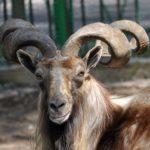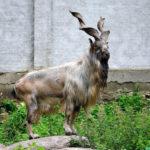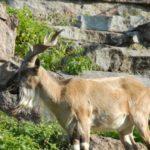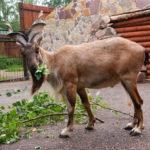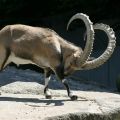Description and where the scorpion goats live, the status and position of the species in nature
The habitat of the scorch goat is the mountains of Central Asia. But even the difficult accessibility of this region does not save them from destruction. Poachers are interested not only in nutritious valuable meat, but also in spectacular one and a half meter horns of animals. Therefore, the species is endangered - in the wild there are only about two and a half thousand individuals of the goat-horned goats.
What does a horned goat look like?
Also known as markhor, the species name in Latin Capra falconeri was named after Hugh Falconer, a botanist from Scotland, and was first described only in 1839. This species of bovine artiodactyls is rather large: in length - 150-170 centimeters, and the height of the withers of males is up to a meter. Their weight is about 80-90 kilograms, females are almost two times lighter. The color of young animals is reddish-gray, in old horned males the coat is off-white. The goats have a thick long beard, and on the chest and neck there is a thick dewlap of elongated wool, which acquires a special splendor in the cold winter time.
The head is slightly humped. The horns look like a corkscrew - each is twisted around a straight axis. In goats, they sometimes exceed one and a half meter length, having 2-3 turns. At the base, the horns are drawn together, and then deviate back and diverge to the sides. The boundaries of the annual segments appear on the surface. The horns of the horned goats are small - no more than 30 centimeters. They are curled like those of males, but less flat.
According to slight differences in color and the degree of twisting of the horns, up to six subspecies of scorchor goats are distinguished. Their habitats are quite territorially separated from each other. It is believed that the mountain goat is one of the progenitors of domestic goats.
Where does this animal live?
Small populations of the scintor goat species are observed in the mountainous regions of northwestern India, Pakistan and Afghanistan. It is believed that one of the largest populations of horned artiodactyls in natural conditions lives on the slopes of the Kugitang ridge, in the eastern regions of Turkmenistan. There are fewer of them in Uzbekistan, at the headwaters of the Amu Darya River, in the interfluve of Vakhshcha and Pyanj in the southwestern region of Tajikistan.
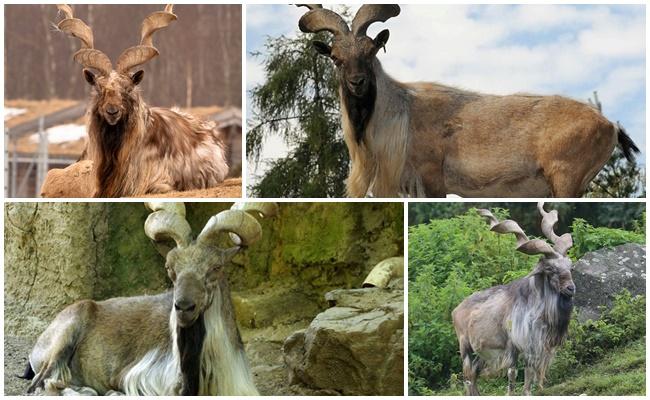
Place of residence
The horned goats most often settle on the slopes of the rocks, where areas with grass and rare bushes have been preserved.In summer, most of them do not rise above 2500 meters above sea level, but some males reach the upper boundaries of alpine meadows and the beginning of the snow belt. In the winter cold, scythe goats descend to where the snow cover is less, - to mountain belts at an altitude of 500-900 meters, sometimes coming close to human settlements.
Lifestyle
Goat-horned goats keep in small groups. Usually these are two or three queens with calves up to two years old. Markhorod males, as a rule, form their own small "companies" of several heads or lead a solitary life.
In more numerous herds of 10-20 individuals, animals gather during the autumn year and in the cold in winter. At the same time, high-ranking ones are located in the center of the group, and weak, sick, and other low-ranking ones are located on its periphery. Adult goats in such herds make up only 6-10% of the total number, since they often die. In the autumn, two-year-old young scorch-horned goats that have grown up leave their mothers and begin an independent life.
In summer, markhoors go out to graze early in the morning and at dusk, when the heat subsides. In winter, they spend almost the whole day in search of food. Goat-horned goats are vigilant and careful: they often raise their heads even while grazing, inspecting the surroundings. Noticing danger, they shout sharply and stamp their feet strongly. This is a signal to the others to be on the alert. If the detected source of threat - a predatory animal or a person - is far away, and it is clearly visible, the herd remains in place, watching him. As soon as he is out of sight, the animals quickly move to a safer place, usually to the nearest rocky slope.
Scotch goats rarely live longer than 10 years under natural conditions. This is not their age - they are more likely to die from predators, avalanches or not surviving cold winters. In captivity, their lifespan is extended to 15-19 years.
Animal nutrition
In summer, herbaceous plants - rhubarb, desert sedge, ziziphora, bluegrass, prangos - form the basis of the diet of the horned goats. Young shoots of cereal crops are a special treat for them, but foliage, thin twigs of shrubs and trees are also eaten. In winter, animals find remnants of dried grasses, gobble up shoots and branches of honeysuckle, mountain ash, willow, almond, aspen, maple, and various small shrubs.
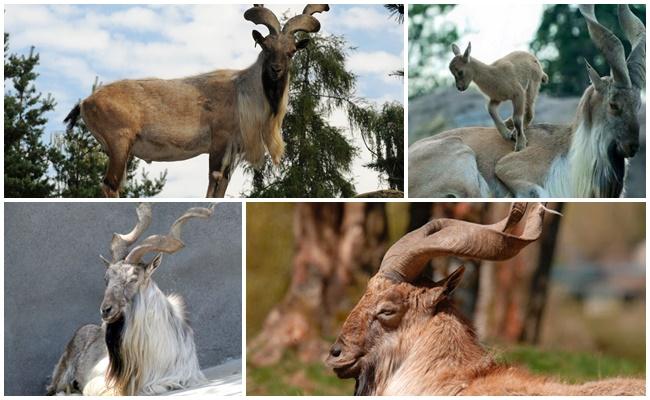
If succulent grass is abundant, this may be enough for some time to quench their thirst. Usually they are looking for a permanent place for watering - a river, stream, pond formed by melted snow or rains. In the cool part of the day, animals visit it twice - early in the morning and at the beginning of the night, in the heat they additionally come at noon.
Reproduction of horned goats
Young goats are ready to reproduce at the age of three. The horned males become sexually active two years after birth. The rut begins in November and lasts until early January. It is accompanied by the release of a large amount of hormones into the bloodstream, therefore, in search of free females, the goats constantly arrange fierce battles with each other: they dig the ground with their hooves, stand on their hind legs, scatter, hit with their foreheads or the base of the horns.
They, as a rule, do not inflict serious damage to each other, but they lose a lot of strength and by the middle of winter they lose a lot of weight. The horned females remain calm during estrus and do not lose weight.
Usually, a scythe goat forms a harem for itself from several goats. Pregnancy lasts a little longer than five months. In May, first-calves often bring one kid, multiparous ones - two babies. The first day the calf is in a rookery in a secluded gorge, which the mother finds in advance for lambing, and from the second day of life follows her to the nearest pasture, already from a week of age trying green food. The mother feeds the offspring until the autumn months, but the kids stay with her for a couple of years.
An interesting fact: even after leaving the herd, young sexually mature goats cannot always immediately begin to reproduce, driven away from females by older males. Sometimes the horned goats have to spend several years alone, gaining strength.
View status and position
The catch of the scythe goat, masterfully moving on the hard-to-reach rocks, has always been a proof of the high degree of the hunter's skill. The animal is not only of gastronomic interest; its beautiful large horns are also a valuable trophy. Since their owners are large and strong males, the main producers of the herd are destroyed.
Human economic activity also contributes to a decrease in the number of goat goats: sheep flocks are displacing them from convenient pastures, so now small numbers of markhor remain only in the most inaccessible rocky areas and on the territory of protected reserves. Since the horned goat species is threatened with complete destruction in the wild, it is included in the Red Book and a special Appendix to the Convention on International Trade.
The experience of aviary breeding has proven the success of such breeding of scorch horned goats. A number of zoos are home to their fourth generation.

